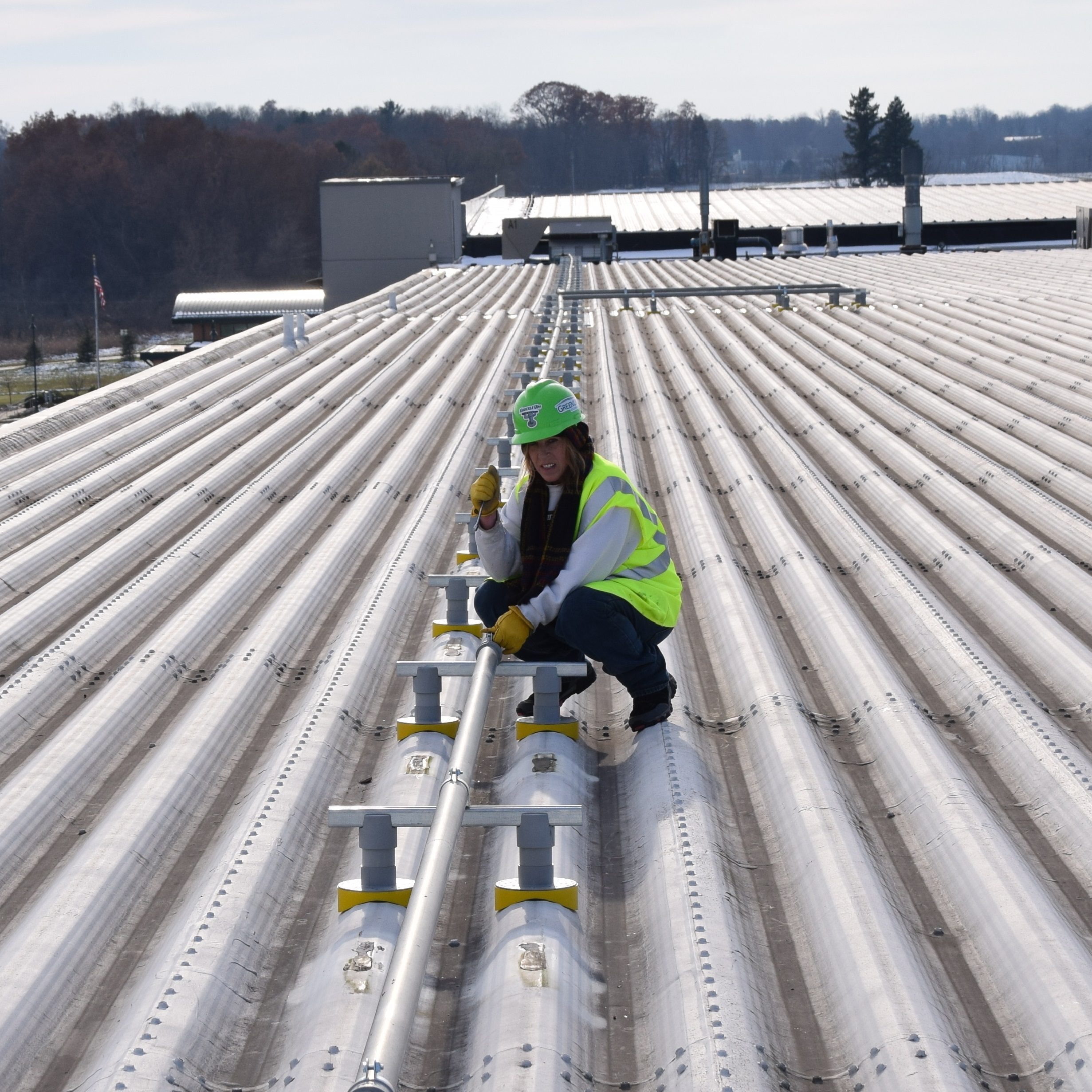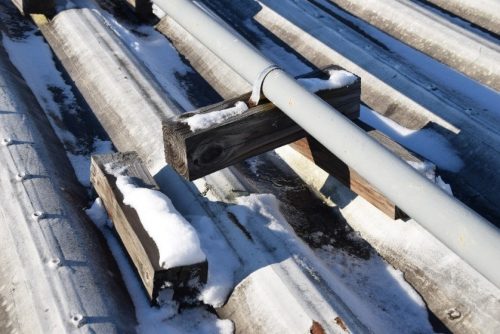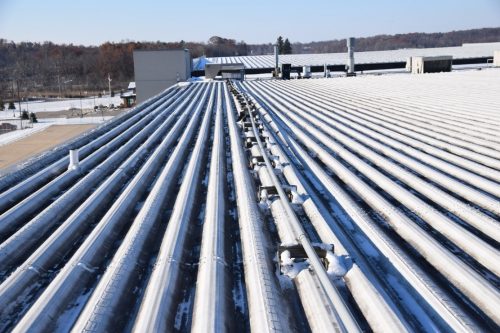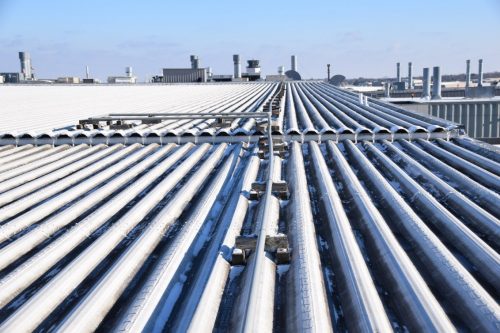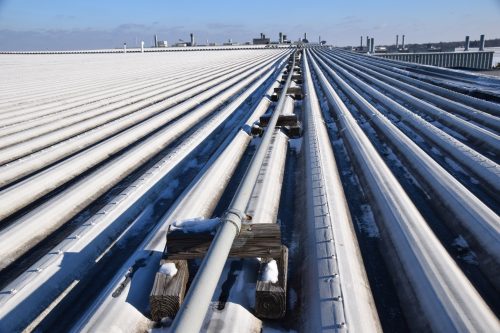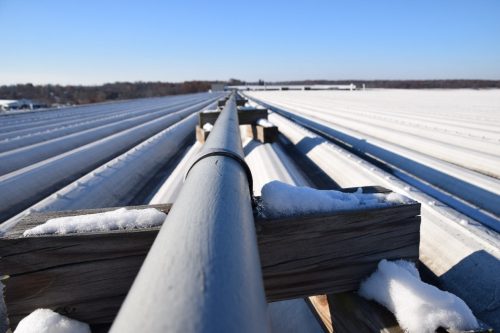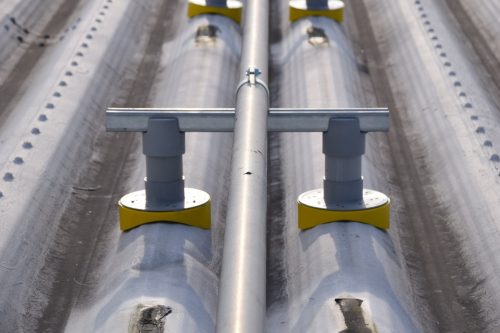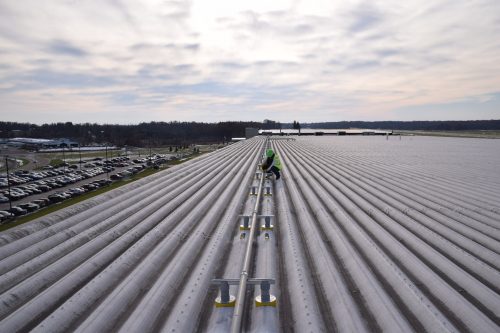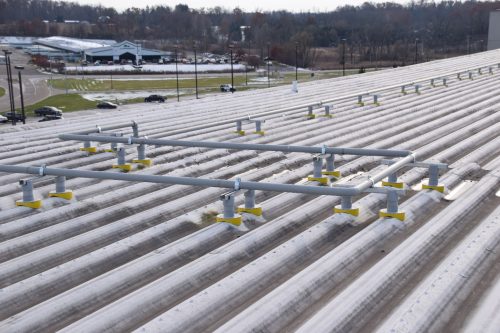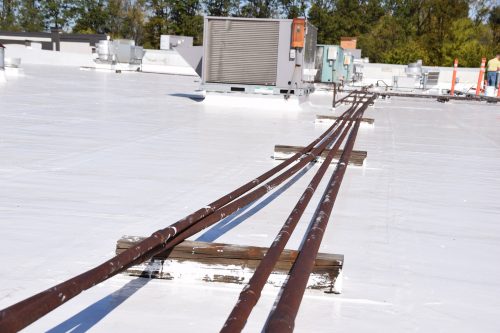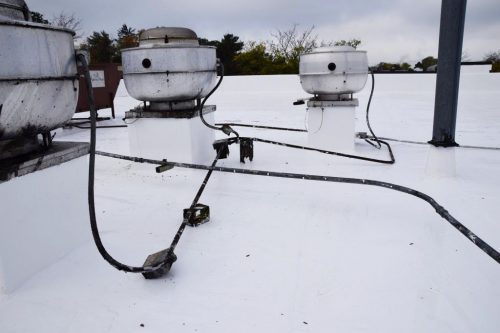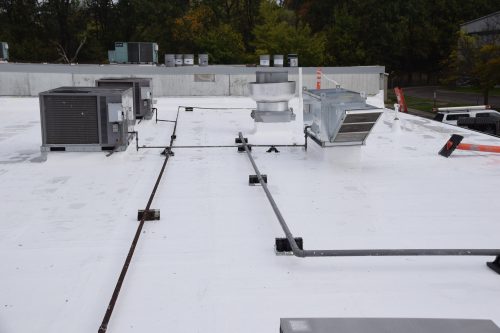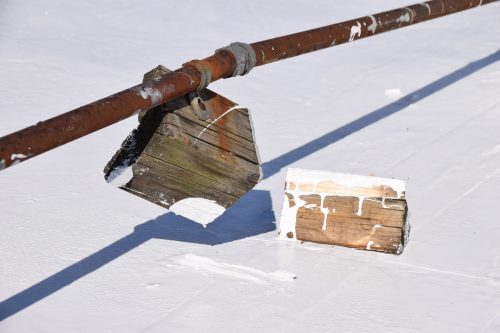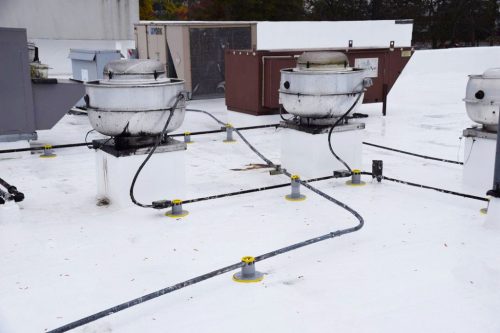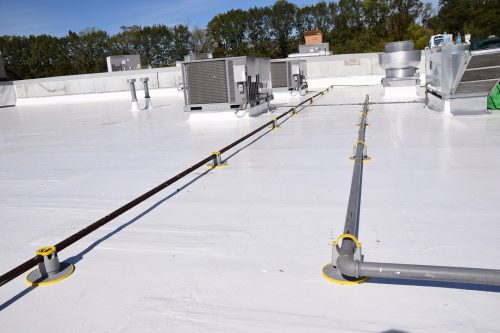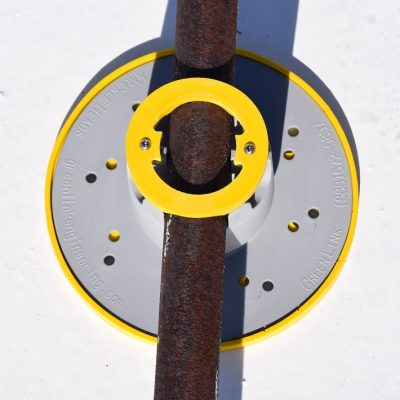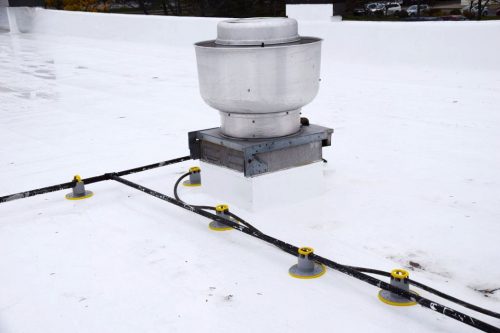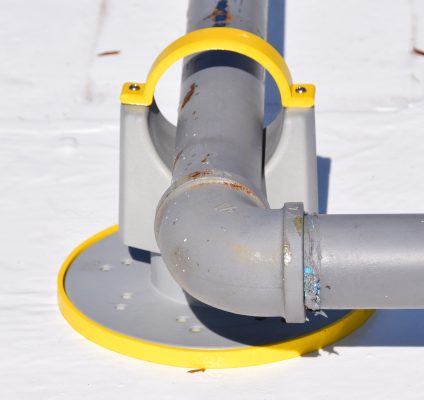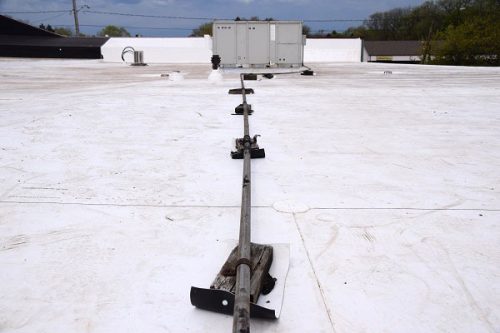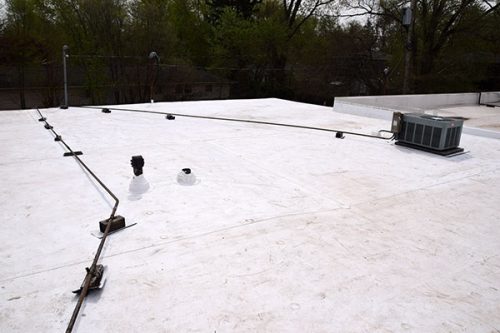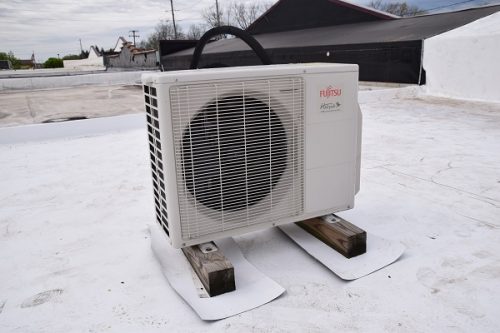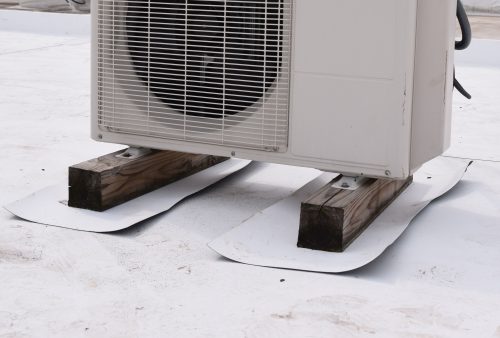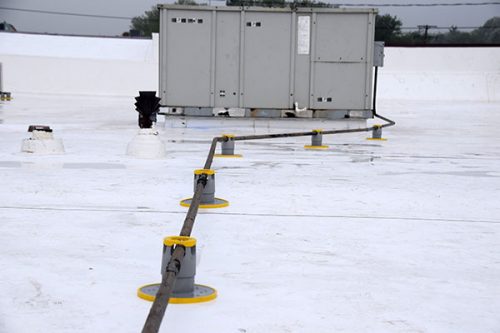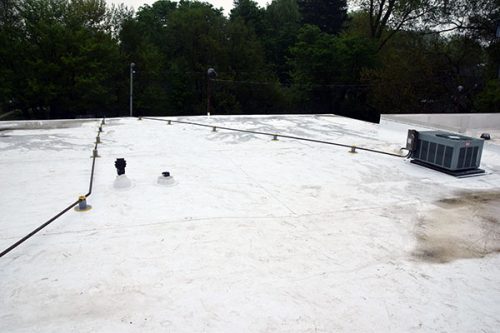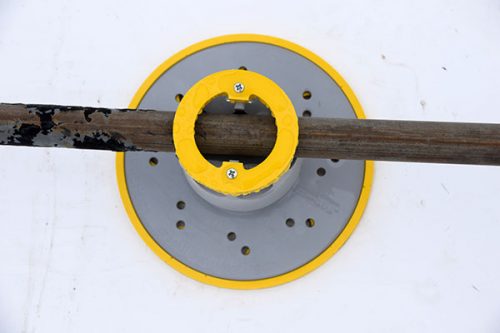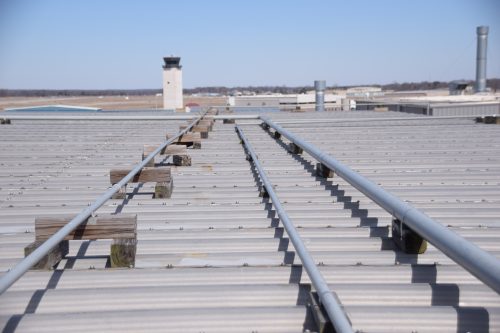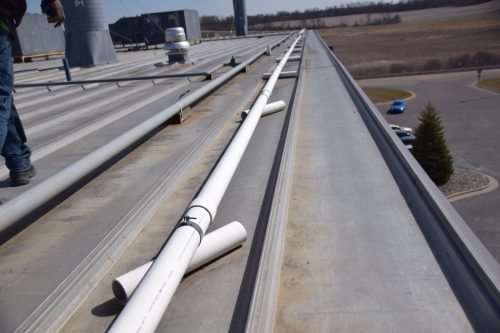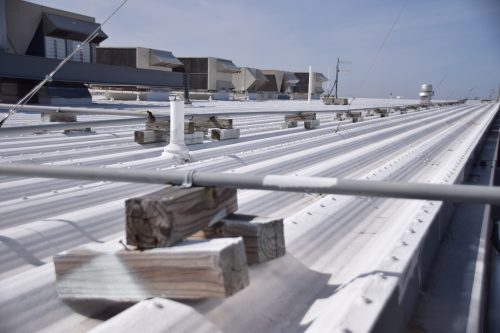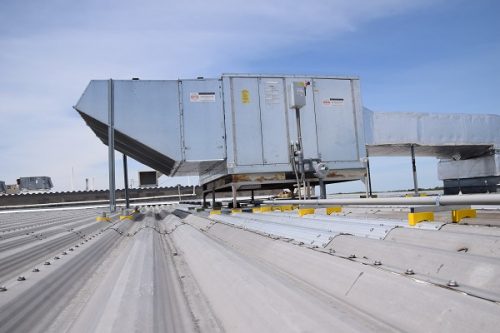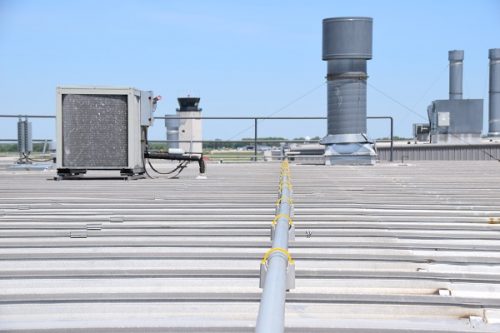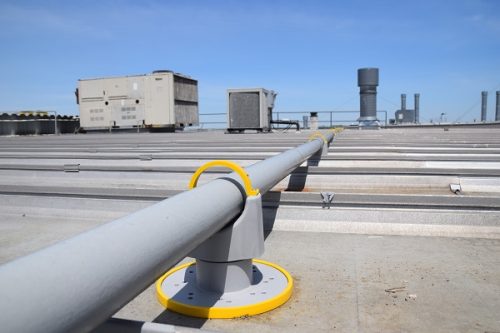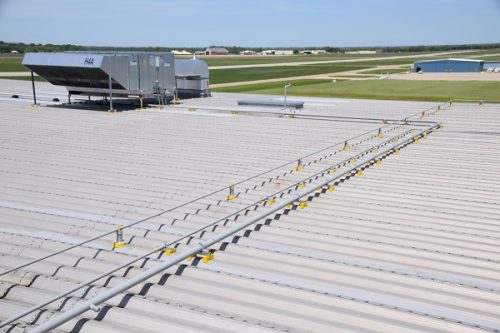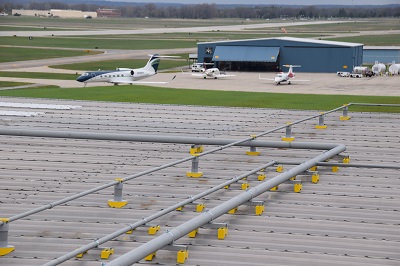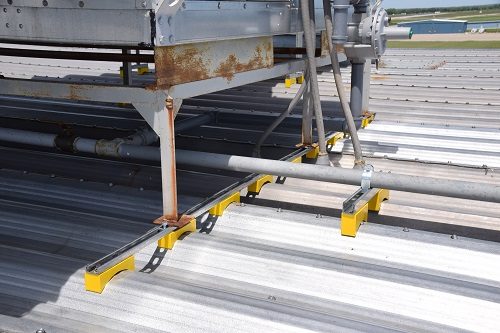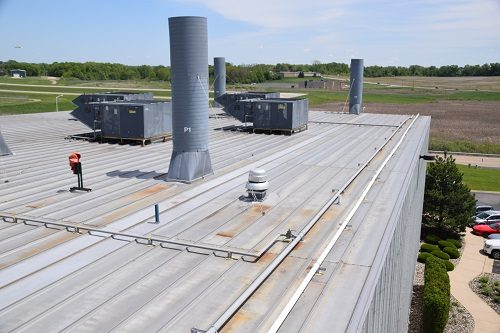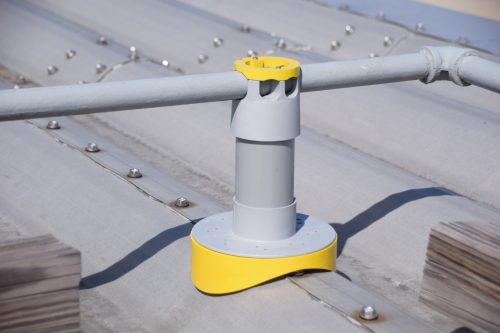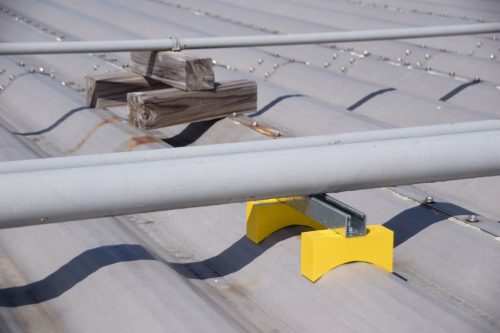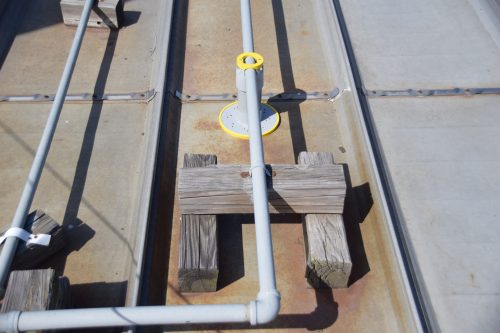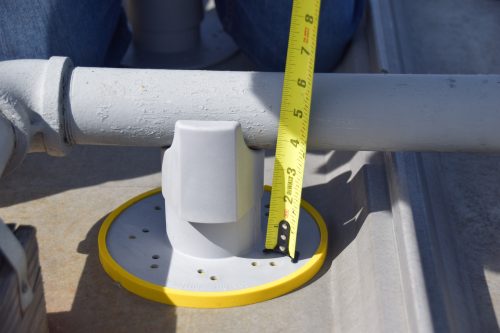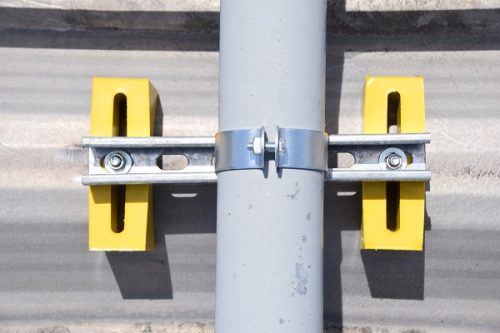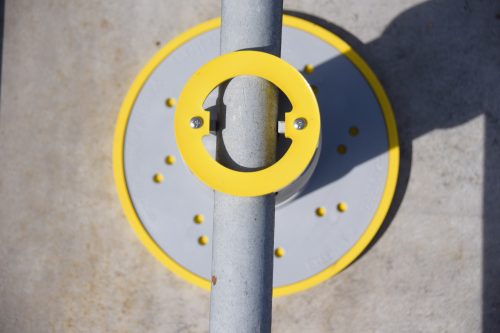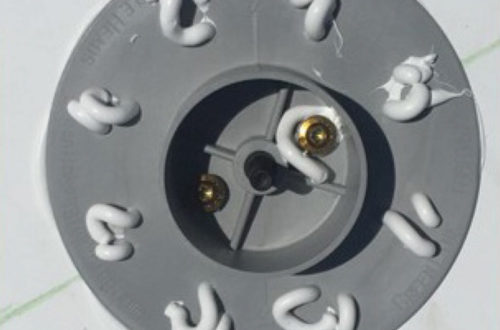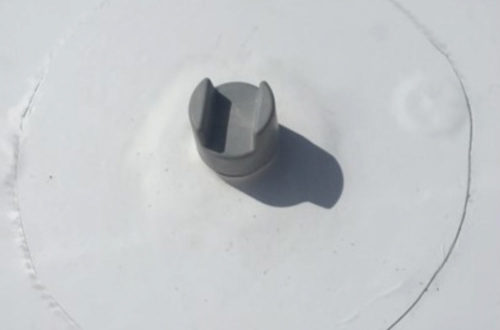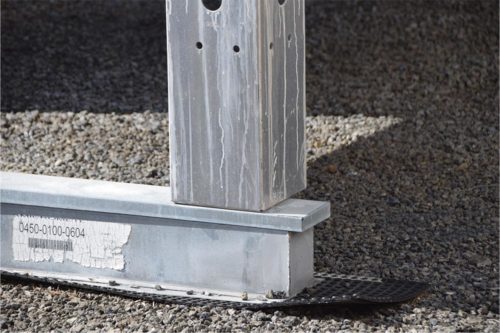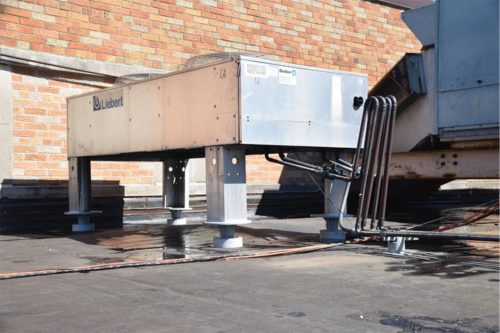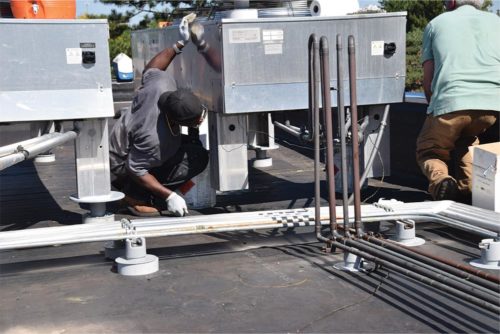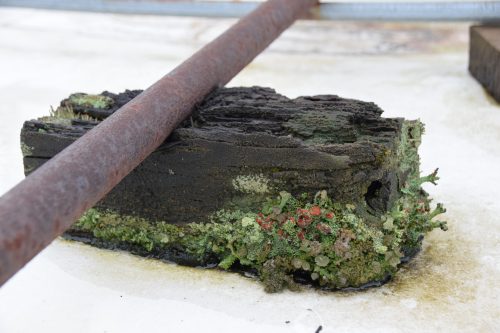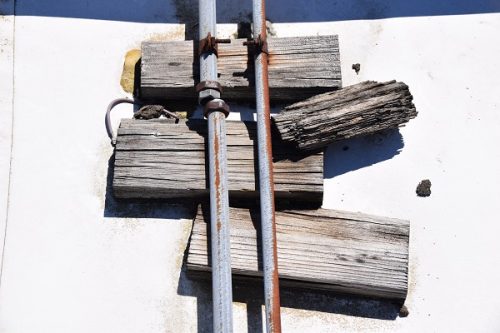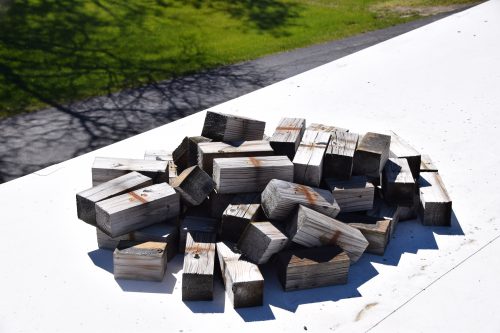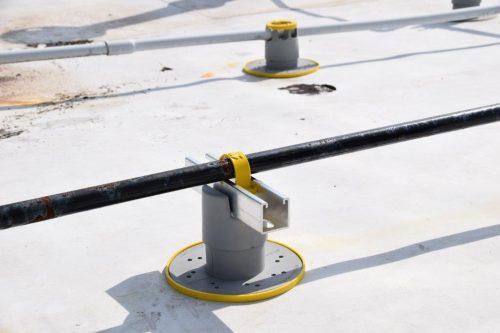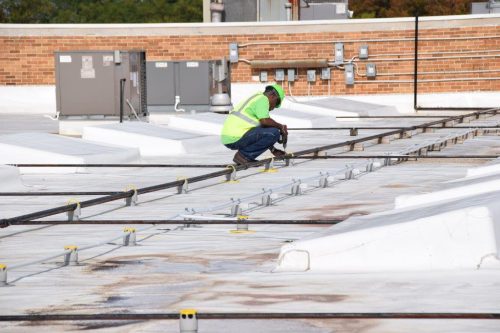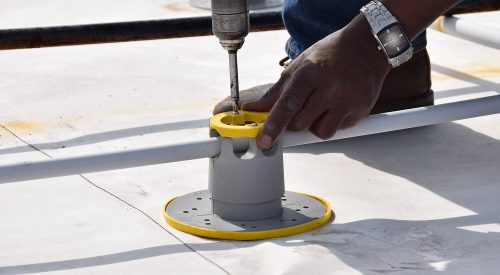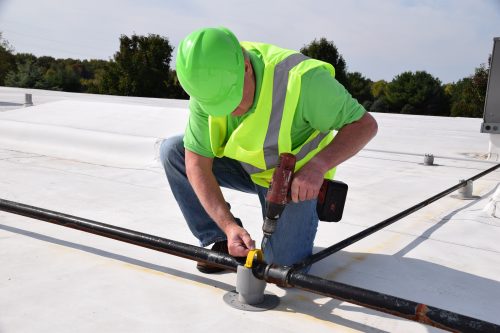Projects
Duncan Aviation: Phase II
This job was the second phase of an earlier project involving the roof of an airplane maintenance facility. This phase II project required replacing aging wood sleepers supporting 400 feet of a roof-mounted gas line. The roof was built with an upper and lower section each about 200 square feet with a 2 ½ foot drop off. The gas line consisted of 21 sections with an expansion joint about halfway down the length.
The original system featured two parallel wood 4x4s positioned on the ridges with a cross beam for supporting the pipeline. The steel corrugated roof over the airplane hangar presented an unusual challenge because of the absence of a flat surface on which to position the support system. Some of the sleepers had begun to split and crack and others had slipped into the valleys of the corrugated roof, stressing the gas line and expansion joint and causing them to contort.
As in phase I, GREEN LINK custom-molded polyurethane saddles were placed over the corrugated ridges to provide a flat surface on which the KnuckleHead system would sit. The saddles were loose-laid, but the KnuckleHead bases were bonded to the saddles using GREEN LINK Adhesive/Sealant to secure the installation.
Two installers worked in tandem moving down the pipeline, one removing the wood supports with the other following behind to install the GREEN LINK KnuckleHead system, straightening the pipe and expansion joint along the way. The GREEN LINK system consisted of parallel pairs of Strut KnuckleHeads into which a steel channel was positioned to support the pipeline. The KnuckleHeads included extensions to ensure that the pipeline would consistently remain 7 ½ inches off the roof ridge. GREEN LINK Adhesive/Sealant was used to bond the channel into the strut head. The pipe was then clamped into position.
Replacing the sleepers with the lighter-weight KnuckleHead system removed an estimated 539 lbs. of point loading from the roof. The two-person crew completed the job in less than 7 hours.
BEFORE THE INSTALLATION
FINISHED PROJECT
Replacing Wood Blocks with The KnuckleHead Rooftop System
This project involved replacing wood blocks with KnuckleHead supports as part of roof upgrade on a retail building in East Lansing, Michigan. The contractor had applied a two-coat liquid polyurethane coating over an aging BUR. Installers had to work around dozens of deteriorating wood blocks which had been used to support multiple steel gas lines and some electrical conduit coming from HVAC units.
Following the completion of the topcoat, GREEN LINK personnel handled the removal of the blocks and the installation of the KnuckleHeads. Three types of KnuckleHeads were utilized: Heavy Pipe supports for 2½-inch nominal pipe size steel gas line pipes, Lite Pipe KnuckleHeads for smaller lines ranging from ¾” to 1 ½” diameters, and Strut KnuckleHeads for steel channels which supported pipeline clusters. The Knuckle Head designs contributed to an easy and efficient replacement strategy. KnuckleHeads were placed under the pipes and conduits adjacent to the wooden blocks.
Because KnuckleHeads can be elevated by turning the heads clockwise, this allowed the pipes to be raised above the wood blocks so they could be removed. The wood supports had to be cut out with a razor edge because the coating had been applied from the roof surface up along the sides of some of the blocks. Once the blocks were removed, the contractor was able to apply liquid urethane to the uncoated areas.
The loose-laid KnuckleHeads were then lowered to the desired height and spaced to provide optimum load distribution. Each KnuckleHead was placed on a GREEN LINK KnucklePad, a yellow-tinted urethane pad to protect the roof coating. The project involved approximately 100 KnuckleHeads: 40 were utilized to support steel channels ranging from two feet to six feet in length; 30 large pipe supports and 30 lite pipe supports completed the job.
BEFORE THE INSTALLATION
FINISHED PROJECT
No Sleepers on the Job: Rooftop Supports Matter to Any Building Owner
This project involved reroofing a retail business located in a Kalamazoo, Michigan strip mall. Pipes and equipment were originally supported by wood sleepers. The selected bid called for putting the original wood sleepers back into place, but at the owner’s request, they were replaced with KnuckleHead Supports.
The building owner received three bids for a 6500-square-foot reroof job and selected the contractor based on reputation and quality. The winning bid called for a tear-off of 1 inch of BUR roofing and perlite substrate. The original 3” polyisocyanurate insulation was determined to be in good shape, so it was not replaced. Mechanical attachment of ½” Dens Deck was installed according to the manufacturer’s specifications. The contractor then followed with heat-welded Duro-Last® white single-ply membrane as well as a 2-piece fascia with Kynar® finish.
HVAC equipment and associated pipelines were originally placed on wood sleepers. The bid did not call for the replacement of the sleepers, so following the installation of the membrane, original wood blocks, some of which had already deteriorated from weathering, were put back in place. The building owner was familiar with the KnuckleHead product line and requested that the contractor replace the original sleepers with KnuckleHead supports. The completed job required 4 Strut Supports, 14 Lite Pipe Supports, 18 non-slip protective KnucklePads, and 14 KnuckleCaps for securing pipes.
Following the completion of the project, the owner stated, “I had a nice new roof and I wanted to make sure the support system matched the quality of the roof. The KnuckleHeads represented very little additional cost, and now I can be sure that all that stuff up on the roof is secure and safe for the long run. The finished job looks great.”
BEFORE THE INSTALLATION
FINISHED PROJECT
Custom Engineering of KnuckleHead Supports
This project involved a combination of standard KnuckleHead Lite Pipe, Heavy Pipe and Strut Supports along with GREEN LINK custom-molded products that were engineered to fit the specific demands of the roof structure.
An airplane maintenance facility located in southwestern Michigan required the replacement of its rooftop pipe system, which utilized wood sleepers of varying sizes. Loose-laid sleepers are subject to movement, over time causing pipes to bend and contort. In addition, the wood will deteriorate and rot from weathering and biological attack. In some cases, the rotting wood allows screws to loosen causing brackets to detach so that they can no longer hold pipes in place. A section of the steel corrugated roof presented an unusual challenge.
Specially designed polyurethane saddles were custom molded by GREEN LINK to fit on top of the corrugated contours of the roof. One design accommodated a steel strut for supporting multiple large pipes in a perpendicular configuration, while another design accommodated the Lite Pipe KnuckleHead for supporting smaller pipes. Additionally, a section of the roof featured a standard low-slope design. Here, standard Lite Pipe and Heavy Pipe KnuckleHead Supports with extensions and KnucklePads met the requirements of the job. Both Lite Pipe and Heavy Pipe supports were capped using KnuckleCaps and KnuckleStraps to secure pipes in place.
BEFORE THE INSTALLATION
DURING THE INSTALLATION
FINISHED PROJECT
Preventing Leaks When Penetrating the Membrane
When mechanical fasteners are used, a patch can be applied to ensure there are no leaks. First GREEN LINK Adhesive/Sealant is used to bond and seal the base. Next a patch cut from the TPO membrane is placed around the KnuckleHead and heat welded in place.
This project on a California gas station involved the installation of solar thermal panels over an approximately 8,000-square-foot roof covered with TPO single-ply membrane. Strut KnuckleHeads and extensions supporting Unistruts were used to angle the panels at 15 degrees.
The contractor applied 1/4-inch screws to install the KnuckleHead bases. To prevent possible leaks caused by penetrating the membrane, the contractor first used GREEN LINK Adhesive/Sealant to seal around the base, followed by the “patch method.” Round sections, or “targets,” cut from the TPO membrane were placed over the base and heat-sealed around the edges to prevent possible leaks. The installation was approved by the building inspector.
Paver and Strut KnuckleHeads Upgrade Cooling System Support During Re-Roofing
This project involved the installation of KnuckleHeads to improve the support structure of a rooftop cooling system during a commercial re-roofing job.
The building was an approximately 28,000-square-foot facility housing a large internet service provider located in Southfield, Michigan. The cooling system included three large chillers and associated pipes and conduits that were originally supported in some areas with wood sleepers sitting on top of polypropylene bases and in other areas with galvanized steel curbs. In places, the chiller feet were cantilevered on the steel curbs. EPDM membrane was used to replace the original coal tar roof. The chillers and piping were gently lifted during tear-off and membrane installation, then reset using two types of GREEN LINK KnuckleHeads. To support the chiller feet, Paver KnuckleHeads were selected. But because chillers are sensitive to leveling—fans operating in units that are not level will burn out their bearings more quickly—the paver supports were modified. The standard paver 7” head was expanded to 12” to comfortably accommodate the full footprint of the chillers, eliminating any cantilevering. GREEN LINK Adhesive/Sealant was used to bond KnuckleHeads to polyester risers, which were loosely laid onto EPDM slip sheets. Because KnuckleHeads are height adjustable, a level, evenly distributed load was achieved. In addition to the modified paver KnuckleHeads, strut KnuckleHeads were installed to support the Unistrut steel channel for elevating piping and conduit. The re-installation of the cooling system was completed in a day.
BEFORE THE INSTALLATION
FINISHED PROJECT
Replacing Wood Sleepers on Low-Slope Roof
This low-slope TPO roof on a public-school building in Michigan shows the flaws of using wood sleepers and the advantages of Solar / HVAC KnuckleHeads for pipe supports.
Loose-laid sleepers are subject to movement, over time causing pipes to bend and contort. In addition, the wood will deteriorate and rot from weathering and biological attack. In some cases, the rotting wood allows screws to loosen causing brackets to detach so that they can no longer hold pipes in place. This project involved replacing the sleepers with three types of KnuckleHeads. Heavy Pipe KnuckleHeads were used to support gas lines (black pipes). Strut Supports and Lite Pipe Supports were used for electrical conduit (light grey pipes), which powered multiple HVAC systems. Dual conduit lines were supported by an aluminum channel set in Strut Supports while Lite Pipe Supports were used for elevating single lines.
BEFORE THE INSTALLATION
FINISHED PROJECT
How Can We Help?
Learn more about how our architectural products can extend the life of your roof and protect your investment.


